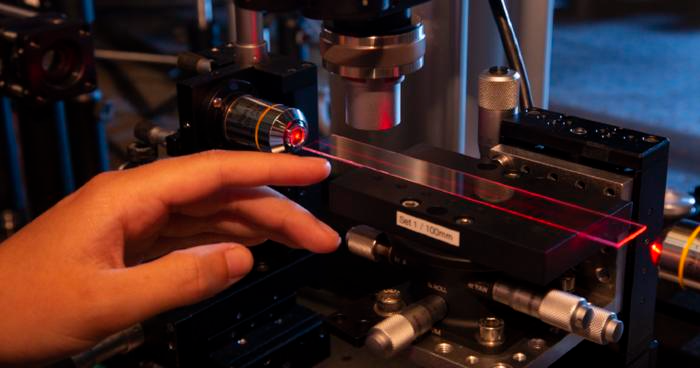The conservation of energy is a fundamental concept in physics that can be used to explain anything from planet orbits to the inner workings of individual atoms.
 A research team from Rostock, Würzburg, and Indiana has shown for the first time that light can propagate without loss in systems that interact with their environment. For their experiments, they used laser-written waveguides as shown here - these are optical structures written into a material by a laser beam. Here, the light signal can propagate robustly and stably and without losses. Image Credit: Julia Tetzke/University of Rostock.
A research team from Rostock, Würzburg, and Indiana has shown for the first time that light can propagate without loss in systems that interact with their environment. For their experiments, they used laser-written waveguides as shown here - these are optical structures written into a material by a laser beam. Here, the light signal can propagate robustly and stably and without losses. Image Credit: Julia Tetzke/University of Rostock.
Energy can be transformed into other forms, but overall energy levels are usually taken to be constant over time. As a result, when attempting to describe a system, physicists typically take care to ensure that it is isolated from its surroundings.
However, a system's dynamics can also be stable if energy gain and loss are distributed in a methodical way such that they cancel each other out under all possible scenarios. This can be guaranteed by a phenomenon known as parity-time (PT) symmetry.
All of the system's parts are arranged so that an exchange of gain and loss of light through the simultaneous mirroring and time reversal makes the system appear unchanged, much like a video that is played backward and simultaneously reflected in a mirror and yet looks exactly like the original video—that is, it is PT-symmetrical.
PT symmetry is not just an academic concept; rather, it has opened the door to a more thorough comprehension of open systems.
Professor Alexander Szameit of the University of Rostock specializes in the intriguing physical phenomena related to PT symmetry. Laser light can replicate the behavior of artificial and natural materials arranged in periodic lattice structures in their customized photonic chips, which makes them an excellent platform for testing a wide range of physical theories.
Professor Szameit and colleagues have thus successfully integrated the ideas of topology and PT symmetry. Topology is the study of properties that remain constant even when the underlying system is constantly deforming. When a system has these qualities, it becomes especially resistant to outside influences.
Szameit’s team uses laser-inscribed photonic waveguides, which are optical structures etched by a laser beam into a material, in the experiments.
In these “circuits for light”, so-called topological insulators are realized.
These insulators have attracted a lot of attention in recent years because of their fascinating ability to convey a lossless stream of electrons or light along their boundary. The unique capability to suppress the impact of defects and scattering makes them particularly interesting for all kinds of technological applications.
Alexander Szameit, Professor, University of Rostock
Up until now, it was believed that open systems and such robust boundary states were fundamentally incompatible. Together, the researchers from Rostock, Würzburg, and Indianapolis demonstrated that it is possible to resolve the apparent paradox by distributing gain and loss dynamically over time.
The light propagating along the boundary of our open system is like a hiker traversing mountainous terrain. Despite all the ups and downs, they will inevitably end up back at the initial elevation of the starting point. Similarly, the light propagating within the protected edge channel of our PT-symmetric topological insulator will never be exclusively amplified or damped, and can therefore retain its average amplitude while enjoying the full robustness afforded of the topology.
Alexander Fritzsche, Doctoral Candidate and Study First Author, University of Rostock
These discoveries may pave the way for the development of new, cutting-edge circuits for the transmission of sound, light, or even electricity. The discoveries also represent a significant advancement in the understanding of topological insulators and open systems.
This research was funded by the German Research Foundation (DFG) and supported by the Alfried Krupp von Bohlen und Halbach Foundation.
Journal Reference:
Fritzsche, A., et al. (2024) Parity-Time-symmetric Photonic Topological Insulator. Nature Materials. doi.org/10.1038/s41563-023-01773-0.